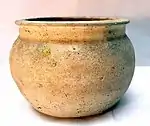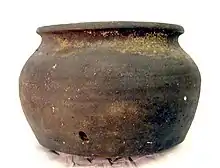English medieval pottery was produced in Britain from the sixth to the late fifteen centuries AD. During the sixth to the eighth centuries, pottery was handmade locally and fired in a bonfire. Common pottery fabrics consisted of clay tempered with sand or shell, or a mix of sand and shell. Pottery forms were common items used for cooking and storage, and were undecorated or decorated simply with incised lines. By the eighth century, the slow wheel was being used by local craftsmen to finish pots. By the late ninth century, potters in urban areas started to mass-produce their products. A larger variety of forms were being made and decorated in new ways. During the tenth century, potters began transitioning to a fast wheel and firing pots in kilns.[1] Grooved lines, thumbed-applied strips, stamping and rouletting were commonly used decorations. From the thirteenth to the fifteenth centuries, glazed and slip pottery appeared more frequently in the marketplace, along with new fabric colours and decorations, and a large number of new forms.[2][3]
List of English medieval pottery
This is a partial list of English medieval pottery.
| Pottery Name | Time period | Characteristics | Origin | Image |
|---|---|---|---|---|
| Brandsby-type ware | 13th to 14th centuries AD | Finer and sandier, more hard-fired than the earlier York Glazed Ware | Brandsby, North Yorkshire |  [4] [4] |
| Coarse border ware | Late 13th to mid 14th centuries AD | Later class of Surrey whiteware | Surrey-Hampshire border area |  [5] [5] |
| Deritend ware | 12th to 13th centuries AD | Three types: Glazed, Reduced and Deritend cooking pot ware | Birmingham |  [6] [6] |
| Ham Green Pottery | Early 12th to mid 13th centuries AD | Two types of decorated jugs: earlier yellow-splashed plain glaze and a later more green glaze | Somerset | .jpg.webp) [7] [7] |
| Humber ware | Late 13th to early 16th centuries AD | Hard-fired, iron-rich usually red-bodied wares | North Yorkshire |  [8] [8] |
| Ipswich ware | Early 8th to 9th centuries AD | Hard, sandy grey ware made in both a smooth and gritty fabric | Ipswich, Suffolk | .jpg.webp) [9] [9] |
| Sandy ware | 8th to 16th centuries AD | Includes a variety of sandy wares | South East England, East Midlands |  [1] [1] |
| Shelly ware | 7th to 12th centuries AD | The fabric is tempered with shell powder or reduced shell, typically handmade until the 10th century. | Thames Valley, East Midlands, South East England |  [10] [10] |
| Shelly-sandy ware | 12th to 13th centuries AD | The fabric is a blend of both sand and shell, most commonly quartz sand and ground-up shell | Greater London | |
| Stamford ware | 9th to 13th centuries AD | One of the earliest forms of glazed English ceramics | Stamford, Lincolnshire | .jpg.webp) [12] [12] |
| Surrey whiteware | 13th to 16th centuries AD | includes Kingston-type ware, Coarse Border ware, Cheam ware | Surrey-Hampshire border area |  [13] [13] |
| Thetford ware | Late 9th to mid-12th centuries AD | Hard sandy fabric, typically grey in colour | Norfolk and Suffolk | .jpg.webp) [14] [14] |
| York Glazed Ware | 12th to 13th centuries AD | The fabric has an open texture and can be light grey, light brown or pink | Hambleton Hills, Yorkshire |  [15] [15] |
Sources
- 1 2 Richards, Julian (25 March 2004). Viking Age England. ISBN 9780750952521. Retrieved 7 June 2020.
- ↑ "Pottery Identification". Peterborough Archaeology. Retrieved 30 August 2021.
- ↑ Blackmore, Lynn; Pearce, Jacqueline (2010). A Dated Series of London Medieval Pottery: Part V. London: Museum of London Archaeology. ISBN 978-1901992939.
- ↑ Mainman, A. and Jenner, A. 2013. Medieval Pottery from York (Archaeology of York 16/9), York, 1230–1245.
- ↑ Vince, A.G. (1985). "The Saxon and Medieval Pottery of London: A Review" (PDF). Medieval Archaeology. 29: 6, 29–83. doi:10.1080/00766097.1985.11735465.

- ↑ Patrick, Catherine; Ratkai, Stephanie (2008). The Bull Ring Uncovered: Excavations at Edgbaston Street, Moor Street, Park Street and The Row, Birmingham City Centre, 1997-2001. Oxbow Books. pp. 93–97. ISBN 978-1842172858.
- ↑ "The Medieval and Later Pottery and Ceramic Building Material from 3, Redcliffe Street, Bristol (BRS03)" (PDF). AVAC Reports. Archaeology Data Service. Retrieved 29 August 2021.
- ↑ Jennings, Sarah (1992). Medieval Pottery in the Yorkshire Museum Medieval Pottery in the Yorkshire Museum. The Yorkshire Museum. pp. 27–29. ISBN 978-0905807041.
- ↑ "Ipswich ware". Oxford Reference. Retrieved 28 August 2021.
- ↑ Powell, Andrew; et al. (2016). Imperial College Sports Ground and RMC land, Harlington. Wessex Archaeology. p. 172. ISBN 978-1874350743.
- ↑ "Medieval and post-medieval pottery codes". Museum of London. Retrieved 29 August 2021.
- ↑ "Summary description of Stamford ware from Cambridge University's Department of Archaeology". Archived from the original on 2 September 2007.
- ↑ Pearce, Jaqueline (1992). Border Wares. Post-Medieval Pottery in London 1500-1700. London: Museum of London. ISBN 978-0112904946.
- ↑ Ayers, Brian; Murphy, Peter; Jennings, Sally (1983). Thetford-Type Ware Production in Norwich. Norfolk Museums Service: East Anglian Report No 117. pp. 61–97.
- ↑ Jennings, Sarah (1992). Medieval Pottery in the Yorkshire Museum Medieval Pottery in the Yorkshire Museum. The Yorkshire Museum. pp. 18–21. ISBN 978-0905807041.